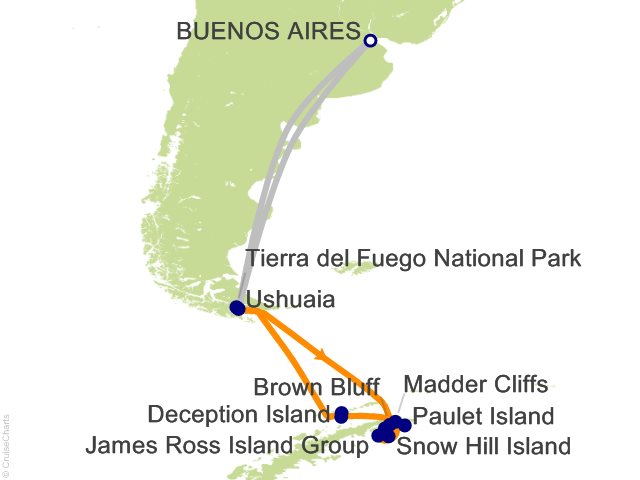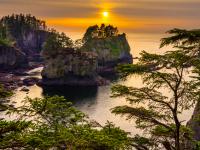The next stage of our specialized itinerary focuses on the rarely visited east side of the Antarctic Peninsula-where few operators visit. We will spend time each day in stunning locations that allow us to enjoy off-ship opportunities shaped by the weather. Our ultimate goal is to maximize your experience of Antarctic wildlife, ice, and landscapes. Our time exploring the Antarctic Peninsula will showcase the flexibility and technical prowess of our industry-leading expedition team, pilots, and crew. They will look for opportunities to experience Antarctica beyond the coast and over the expansive glacial terrain of the last great wilderness. Much of this will be achieved on helicopter flightseeing excursions, which are included in your trip. These heli-flightseeing experiences differ from the helicopter ride that transported you between the ship and the Emperor penguin colony at Snow Hill Island. Helicopter flightseeing enables you to soar freely among the icy peaks of Antarctica while looking out over vast expanses of ice, rock, coast, and sea. Within the eastern Antarctic Peninsula, Antarctic Sound, Erebus and Terror Gulf, and the northwestern Weddell Sea are the main theater for this venture. As we sail though Antarctic Sound, pausing to view stunning fields of tabular icebergs, we'll set our sights on visiting Paulet Island, located in the Weddell Sea. This small, circular island is home to a large Adelie penguin colony. The iconic cone rising up 353 meters (1,158 feet) is a reminder that Paulet Island was once home to active volcanoes. In addition to penguins, you may be interested in visiting the historic hut built by members of the Swedish Antarctic Expedition of 1901-04. Shackleton was aware of this hut-and of the provisions stored there. When he and his crew were forced to abandon the Endurance, Shackleton's objective became clear: to reach the safety, shelter, and supplies at Paulet Island. Alas, as history attests, the ice and current of the Weddell Sea had other plans. We will visit two towering geological features: Madder Cliffs on Joinville Island, and Brown Bluff on the most northerly tip of the Antarctic continent where we plan to set foot. Brown Bluff is believed to be an exposed volcano that once erupted beneath the glacial ice, causing the lava to spread laterally and create the stunning geological layering that's visible on the imposing 745-meter bluff walls. The base of the bluffs is home to rookeries of both Adelie and gentoo penguins, which number in the thousands. During our standard excursion days, we aim to offer a variety of off-ship experiences tailored to the location and weather. These include Zodiac cruises, shore landings on islands and the continent, as well as our paddling programs. Also featured in this portion of the itinerary: the James Ross Island archipelago, adjacent to Erebus and Terror Gulf, which is highly valued geologically. On these islands, we'll find fossilized specimens, ventifacts (ancient rocks polished smooth over time by wind and grains of sand), and the remains of the K-T Boundary, which marks the transition between the Cretaceous Period (dinosaurs and reptiles) and the Tertiary Period (mammals). Our goal is to provide opportunities for guests to see ventifacts up-close, and to better appreciate the significance of wind erosion-by sand or ice particles-over long periods. Ventifacts provide valuable information about the climatic history and prevailing wind patterns of the region. A highlight of the eastern side of the peninsula is Devil Island, marked by its twin towering cones of ash and hardened lava that emerge from a bay on the north shore of Vega Island. At low tide, grounded bergy bits and sea ice reveal the extraordinary visual formations on the underside of the ice-shapes uniquely sculpted by brine channels and ocean waves. Before returning back across the Drake Passage, we intend to visit the wildlife-rich South Shetland Islands. As with any polar expedition, our team has devised multiple plans for our visit to this region. Our ultimate goal, however, is to set foot on Livingston Island, which showcases the most spectacular mountains of the South Shetland Islands, as well as the chinstrap penguin colonies along the rugged coast. The towering peaks you'll see are the Tangra Mountains (stretching 32 kilometers long by 8.5 kilometers wide), Mount Friesland (rising to a height of 1,700 meters/5,578 feet), Bowles Ridge (822 meters/2,697 feet), and Pliska Ridge (667 meters/2,188 feet). One other fascinating landing option is Deception Island. In addition to waddling penguins and lounging seals, visitors can also see the rusting remnants of long-abandoned whaling operations on the beach. We hope to offer guests longer walks leading to breathtaking viewpoints on Deception Island. The stark contrast between the snow and dark volcanic sand-with geothermic steam along the shoreline-creates a uniquely atmospheric feel. Additionally, Deception Island is home to one of the most renowned chinstrap penguin colonies in the world. Estimates range from 50,000 to 70,000. ...
Read More















